Before practice
- What feels heavy in my body right now?
- Which part of me needs the most kindness?
- What is one thing I can leave outside the mat?
Practice on paper
The SoftLight journal is not about tracking perfect streaks or deep poses. It is a place to notice how your body, breath and mood shift from one gentle session to the next.
You can write a full page, or just three words after class. Both count. Over time, these tiny notes draw a quiet map of what truly supports you.
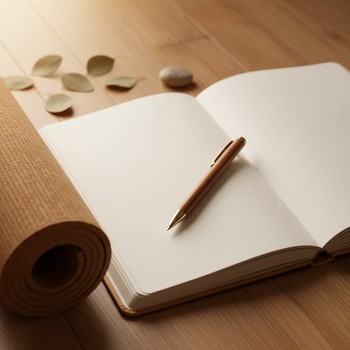
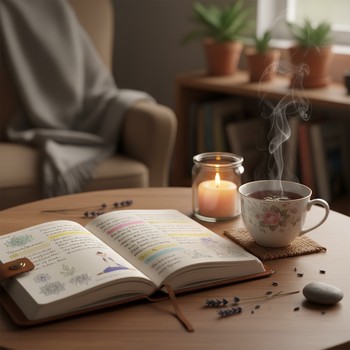

You never have to stare at a blank page. These tiny questions are grouped like constellations, so you can pick just one or two that match the tone of your practice.
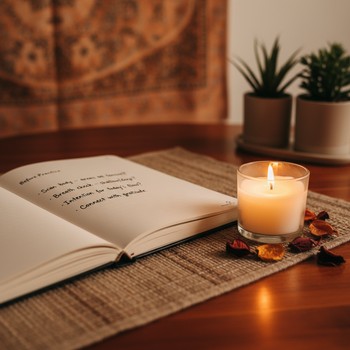
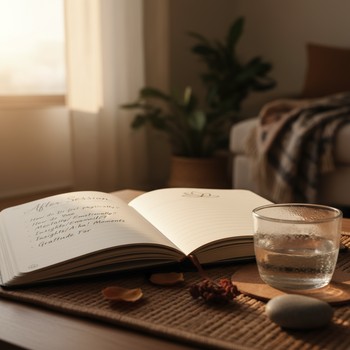
Progress in a soft practice is quiet: a bit more breath, a kinder inner voice, less rush to “push through”. This timeline is a place to honour those subtle shifts.
Week 1 — simply showed up
You write down that you unrolled the mat even though you felt tired or unsure.
Week 3 — remembered one cue
A teacher’s sentence or image sticks with you and returns during a busy day.
Week 6 — softer self-talk
You notice you are a little less harsh with yourself in and out of class.
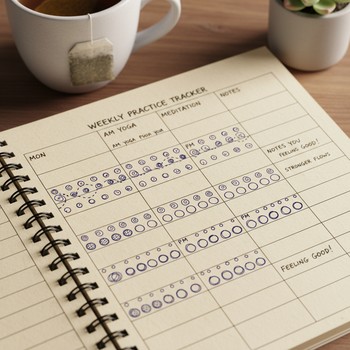
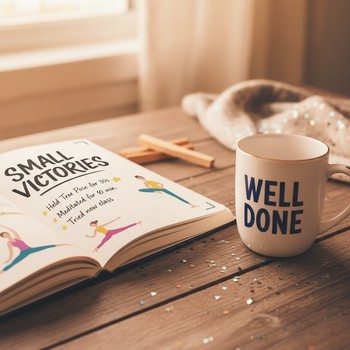
Some days you have a whole page of thoughts, other days only one honest sentence. The SoftLight journal leaves room for both, so you can keep showing up without pressure.
One line
Half page
Full page


Instead of “Did I do enough?”, you can mark sessions with soft words: steady, foggy, playful, heavy, spacious. Over time, they show patterns your body already knows.
You can circle or highlight one word after each class — it takes seconds, but says a lot.
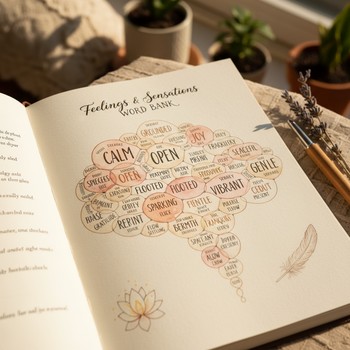
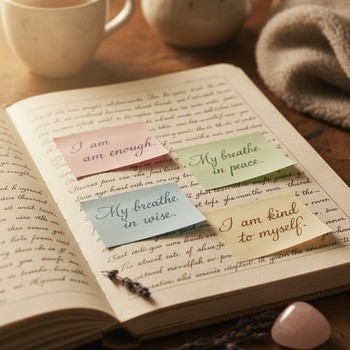
Your practice journal does not have to be fancy. It can be a small notebook by the bed, a note on your phone, or a page in a planner you already use.
A tiny book waiting on your nightstand for one or two lines before sleep.
A slim journal that travels with you for notes after classes or travel sessions.
A simple note app where you add one line after pressing “end” on a video session.


A SoftLight journal page is often a dialogue: one voice that arrives tense and hurried, and another voice — usually softer — that answers back after practice.
You can write both voices down. Over time you will see how your kinder voice becomes easier to access, even on days without yoga.
Before session
“I feel behind and tight everywhere.”
After session
“I am still tired, but my breath feels slower and my chest softer.”
Before session
“My mind is too noisy to even try.”
After session
“The thoughts are still here, but they feel a little further away.”
Before session
“I should be stronger by now.”
After session
“I am surprised how gentle movement still counts as care.”
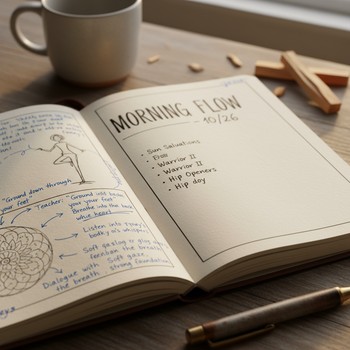
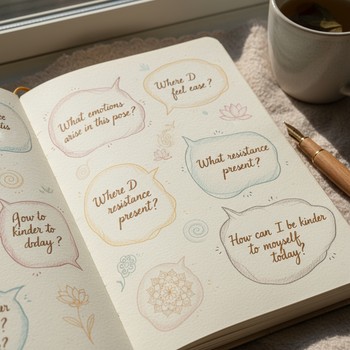
A quick highlighter mark after each session can say more than a paragraph. You can give each colour a meaning: calm, proud, wobbly, comforted.
At the end of the week, look at the pattern of colours instead of counting how many sessions you “completed”.
Sample colour map
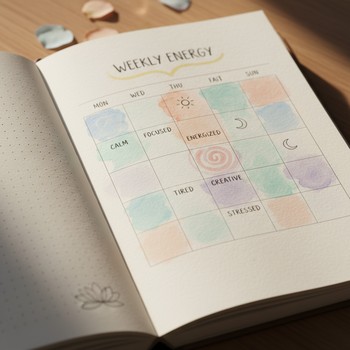
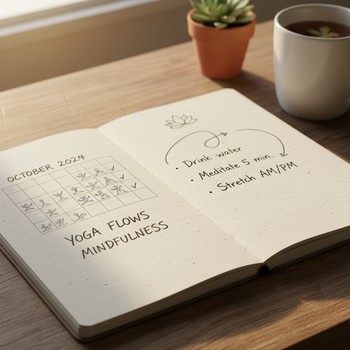
Some entries will be messy, tear-stained or unfinished. SoftLight journaling makes room for those days too, without turning them into a problem to fix.
These pages often become the ones you are most grateful to reread months from now.

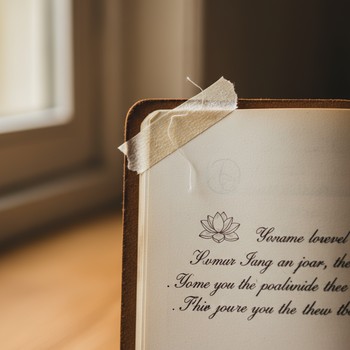
Some people like to note not just “good” or “bad” sessions, but how their energy shifts from morning to afternoon to evening. Your journal can hold these gentle patterns.
You do not have to be precise. A simple arrow up or down, a colour, or one word per part of the day can slowly show what supports you most.
Morning
“Sleepy but hopeful”
Midday
“More awake after moving”
Evening
“Tired but calmer”
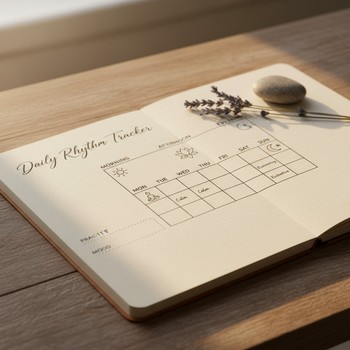


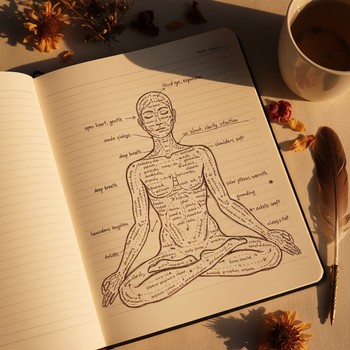
A body map is a simple outline where you can mark tension, ease and tiny changes. It is not about anatomy knowledge — just your own experience.
A few dots or small clouds around the areas that feel tight before practice.
After class, circle any place that feels even a little lighter or warmer.
Write “safe”, “supported” or “breath arrived here” so you remember what helped.
Future-you will forget how hard it once was to begin. Writing short letters after your sessions keeps a trace of what you overcame, and what helped you stay.
Letter from today
“I nearly cancelled, but the first soft forward fold reminded me why I came.”
Letter to six-months-from-now you
“If you are reading this, it means you kept choosing softness more often than before.”
Letter for a harder season
“You do not have to return to where you were. Just unroll the mat and breathe with me.”


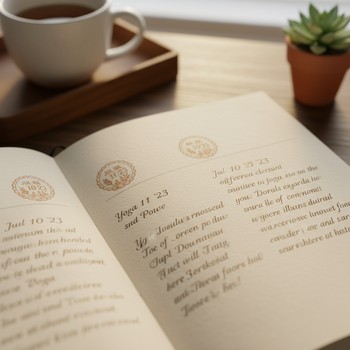
A monthly spread lets you see your practice at a glance: the weeks you showed up, the evenings you chose rest, the days that felt unexpectedly spacious.
You can keep it simple: a tiny mark for each session, one colour for calm, another for “I am proud I came at all”.

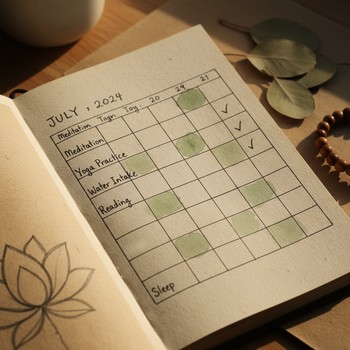

Sound, light and scent can help your mind recognise that journaling time has begun. A soft playlist, a small candle, a favourite blanket — your pages will start to carry that same feeling.
Your ritual does not have to be perfect. Even lighting the same small candle can tell your body, “We are safe to write now.”
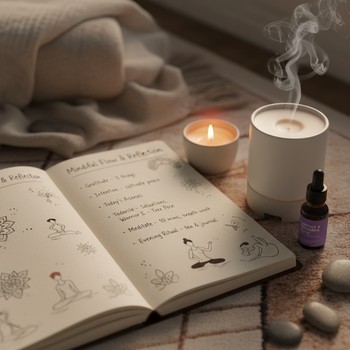
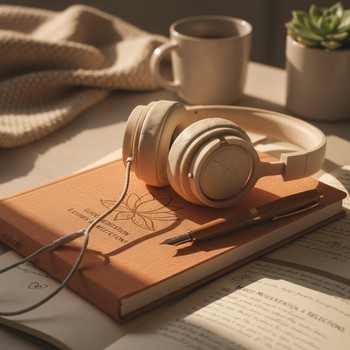
Months from now, you might flip back and be surprised by how far you have come. Old entries show how brave it was to keep showing up, even on the days that felt small.
First soft class
A ribbon or sticky tab where you wrote about starting again.
Hard but honest day
A small mark beside an entry that was difficult yet truthful.
Unexpected ease
A symbol where you noticed your body or mind soften in a new way.
When motivation dips, visiting these pages can remind you that softness is already part of your story.


Practice notes do not have to stay in one place. A sentence on the bus, a few words in a café, or a small line in your work notebook can all belong to the same SoftLight journal.
Instead of waiting for the “perfect” journaling moment, you can let fragments appear in the spaces where your life already unfolds.
Commute thoughts
One line on your phone about how your breath felt during today’s session.
Lunch break pause
A tiny reminder of one shape you want to revisit later.
Evening check-in
A few words about what stayed with you long after class ended.


Some practice notes feel light enough to share with a friend or a teacher. Others are just for you. Both types of pages are welcome inside the same journal.
Honest entries you do not read out loud, but that make you feel more understood by yourself.
A sentence you might offer to a teacher to explain what is helping or hurting.
You can even draw a small symbol on the corner of pages you never want to show anyone, so you feel safe being fully honest there.


You do not have to write every day for this to matter. A few honest lines each week, scattered across bus rides, late evenings and quiet mornings, will slowly weave a soft record of how you took care of yourself.
Each word you write is another way of saying: “My experience is worth listening to.”
Choose your next SoftLight session and make a note afterwards

